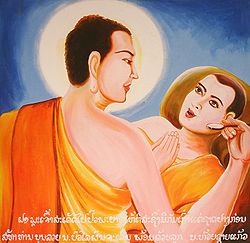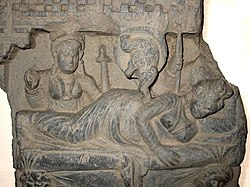Central Asian Buddhist Monks
A Caucasian Central Asian monk, possibly an Indo-European Sogdian or Tocharian, teaching an East Asian monk, perhaps a Turkic Uyghur or Chinese, on a 9th-century AD fresco from the Bezeklik Thousand Buddha Caves near Turfan, Xinjiang, China. A detail from Praņidhi scene no. 5 in Temple no. 9. The book that this painting is reproduced in has full descriptions of these two figures. Relevant details, along with the German descriptions, are found below.
The figure on the right is a young Buddhist monk painted in a stereotypical East Asian style. He stands with downcast eyes directed in reverence as he hears the teachings of the figure on the left. The figure on the left is painted in a style that is not East Asian in character. The two circles on either side of his chin are remarkably unusual (piercings?). He features a strongly-set nose and clear blue eyes. His skin color is darker. His hair and beard color is reddish brown with brown shades. He stands looking at the younger monk, raising his hand in a teaching gesture as he speaks.
Figure on Right: Über den Schirmen erheben sich die Gestalten zweier Mönche. Der rechts stehende ist ein Jüngling mit schablonenhaft gemaltem Gesicht ostasiatischen Typs; er trägt mehrere verschiedenartig gefärbte Unterkleider und daruber einen grünen, rot gestreiften Flickenrock. Er steht mit niedergeschlagenen Augen nach links gewendet in anbetender Stellung da und scheint andächtig den erklärenden Worten zu lauschen, die sein Begleiter an ihn richtet.
In "Tafel 19" of his Chotscho: Facsimile Reproduction of Important Findings of the First Royal Prussian Expedition to Turfan in East Turkistan] (Berlin, 1913), Albert von le Coq identified the figure on the right as a "Tocharer" (i.e. Tocharian) and the figure on the left as "Ostasiate" (i.e. East Asian). In other murals of the Bezeklik Budda Caves, however, foreign-looking Caucasian men have been identified as ethnic Sogdians (an Eastern Iranian people). For instance, Scene No. 6 in Temple 9, in the same temple as the aforesaid mural, modern scholars have identified the kneeling men draped in silk robes as Sogdians (see Gasparini, Mariachiara. "A Mathematic Expression of Art: Sino-Iranian and Uighur Textile Interactions and the Turfan Textile Collection in Berlin," in Rudolf G. Wagner and Monica Juneja (eds), Transcultural Studies, Ruprecht-Karls Universität Heidelberg, No 1 (2014), pp 134-163. ISSN: 2191-6411. See also endnote #32 for further information on source material.)Figure on Left: Dieser, ein alterer Mann im gelb und braunen Flickenrock, besitzt wiederum einen der auffallenden, nicht schablonenhalf gemalten Köpfe, die einen nichtostasiatischen Typus tragen. Er hat rotes Haar und einen roten Bart, dessen Stoppeln in einer sonderbar stilisierten Malweise wiedergegeben werden (man beachte auch die auffälligen nackten Stellen, die rechts und links von der Mitte des Kinnes erscheinen!). Seine Nase ist stark und hervorspringend; die geradestehenden Augen von klarer, blauer Farbe; die Hautfarbe ist rötlichbraun mit braunen Schattierungen. Er steht, den Blick auf seinen jüngeren Begleiter gewendet, mit erhobener Hand lehrend oder erklärend da.
Relevantní obrázky
Relevantní články
Gautama BuddhaBuddha, vlastním jménem Siddhártha Gautama, v páli Siddhattha Gótama. Podle théravádové tradice žil v letech 623–543 př. n. l. Byl zakladatel buddhismu. Jméno Buddha znamená probuzený, osvícený. .. pokračovat ve čtení





















